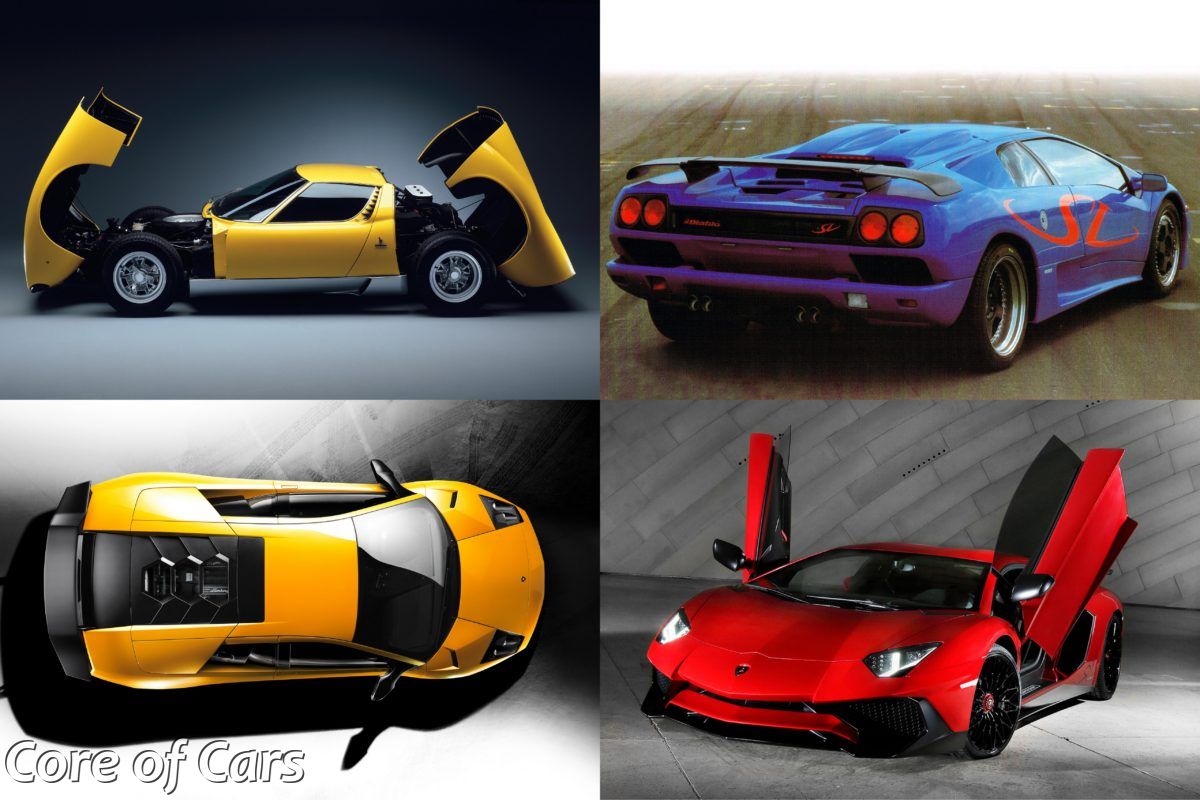SV – these two letters signify a special breed of Lamborghinis, a breed that has been with us for nearly 45 years. Many will recognize an SV as being the ultimate expression and the last hurrah of a given model, but the SV has also been an entry-level and a mid-life model. This is a short story of the various SV models Lamborghini have brought us over the years. As with the article I wrote on Lamborghini’s anniversary models last month, there are four main entries in my list:
1971 – 72: Miura SV (Spinto Veloce)
At the 1971 Geneva Motor Show, Bertone displayed the Miura SV, a significant leap forward compared to the S. However, the launch of the Miura SV went largely unnoticed due to the fact that its neighbour on the stand was the mind blowing Countach prototype.
The successful Miura had seen the development from the first P400 model into the S, and the SV was meant to be the ultimate Miura available for the street. The body received a moderate make-over, the most notable change being the widened rear wheel arches. The iconic “eyelash” grille around the headlights was also replaced by smoothly shaped arches. Despite the overlooked launch, the SV sold well, mainly because it became the ultimate automotive expression of wealth and success, and a total of 150 were made over two years.
1995 – 99: Diablo SV (Sport Veloce)
Again we head to the Geneva Motor Show, where the Diablo SV got its debut in 1995, 24 years after the Miura SV. Lamborghini revived the SV label for their entry-level Diablo model, meant to be a lighter and harder driver’s car. The engine was asked to deliver 510 hp, up from the standard 492, and this was all delivered to the wide rear wheels. During its lifetime, the Diablo SV received minor upgrades, both on the outside and on the engine-side. A total of around 425 Diablo SV’s were made, making it one of the most popular Diablo versions.
2009 – 10: Murciélago LP670-4 SuperVeloce
Guess what, we’re back at the Geneva Motor Show. The 2009 edition saw the launch of the Murciélago LP670-4 SuperVeloce, the final variation on the Murciélago theme. Several design changes distinguished the LP670-4 SV from the LP640, such as the longer nose and the massive wing. Oddly enough, the famous rear wing of the Murciélago SV was an option – the small “lip” style wing was chosen as standard. As the model name indicates, power was up to 670 hp, and the Murciélago SV made use of all its four wheels to get going. It is worth mentioning that the engine found in the Murciélago SV was basically the same as the one devised by Giotto Bizzarrini in 1963 for the very first Lamborghini, the 350 GTV. Changes to the cylinder head, ignition, fuel delivery system and exhaust had allowed this V12 engine to lead a long and successful life, a life that ended with the Murciélago SV. Lamborghini planned to build 350 Murciélago SV, but due to necessary changes in the production line to accommodate for the upcoming Aventador, only 186 were made.
From 2015: Aventador LP750-4 Superveloce
It should come as no surprise that the Aventador LP750-4 Superveloce saw day of light at the Geneva Motor Show, six years after the Murciélago SV, 20 years after the Diablo SV and 44 years after the Miura SV. Lamborghini presented it as “the purest incarnation from the House of the Raging Bull to date”. It is the fastest production Lamborghini ever, and the focus on weight saving and increased aerodynamics were a major reason for the hugely impressive time of 6:59 around the Nürburgring Nordschleife. No planned production number was announced at the launch, but Lamborghini later said they would make only 600 Aventador SV.
Only half a year after its debut, the Aventador SV was launched in roadster guise. Apart from the ill-fated Diablo Roadster SV, this was the first time an SV model came as a roadster, and the success of the Aventador SV Roadster was instant. Production of the Aventador SV Roadster is limited to 500, making it rarer than the coupe, but with a combined production number of 1,100, the Aventador SV is set to become the numerous incarnation of the SV species.
Why no Countach SV?
What about the notable omission – why was there no Countach SV? I believe it has to do with timing, economy and ownership. Towards the end of the 1980’s, Lamborghini experimented with more extreme versions of the Countach, such as the Evoluzione and the L150. The Countach Evoluzione made extensive use of composite materials, and the project was headed by none other than Horacio Pagani. Incredible lightness and increased rigidity made the Countach Evoluzione a veritable speed machine, but the cost of producing it turned out to be too high. The Countach design was ageing, and making large changes to the production process would take a lot of time and money. Incidentally, Lamborghini were bought by Chrysler in 1988, and Chrysler wanted a change in Lamborghini’s image, thus pushing to get something all new launched, namely the Diablo.
This article was first published on lovecars.com.

